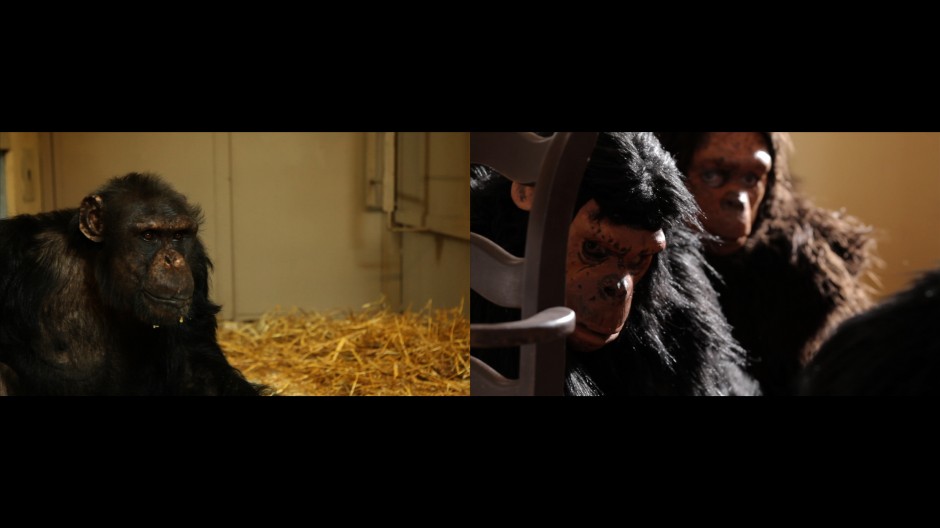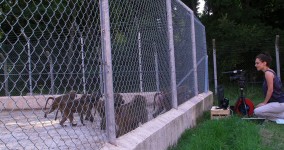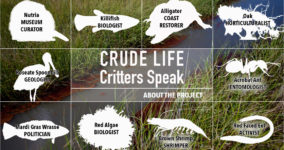
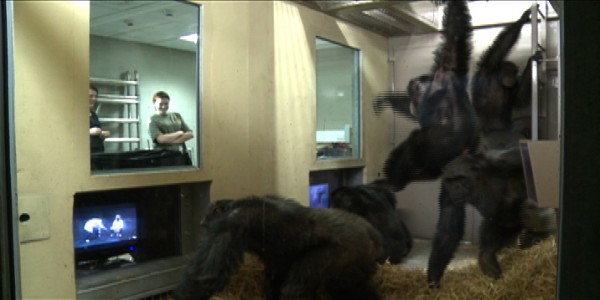
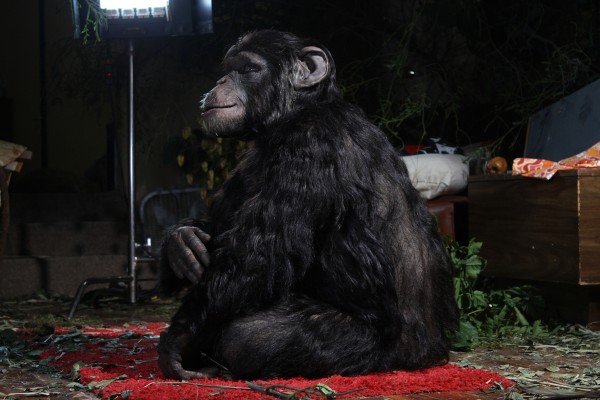
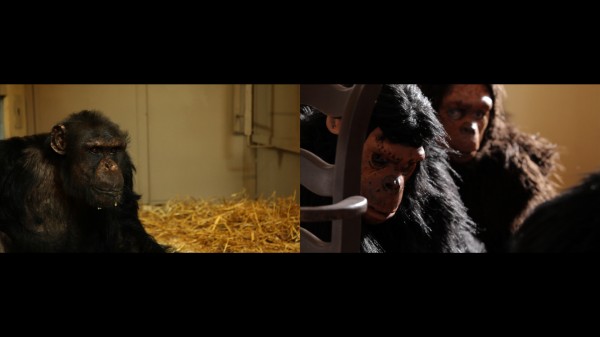

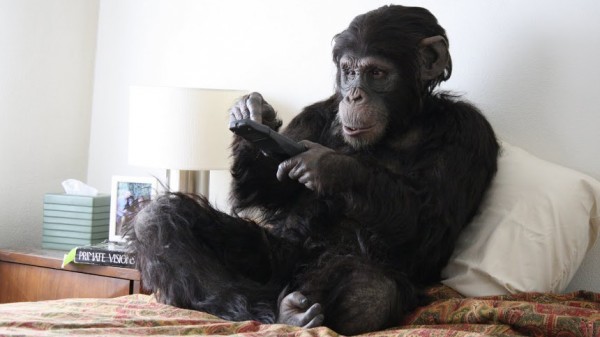
Receiving a major arts award from the Wellcome Trust, and commissioned by The Arts Catalyst, I collaborated with comparative psychologist Dr. Sarah-Jane Vick to attempt to learn chimpanzee preferences for film. We worked with chimps at Edinburgh Zoo’s Budongo Trail, who voluntarily accessed a research pod, viewable by the public. Over several months, I chose a variety of cinematic genres and primate behaviors to show the chimps – animation to documentary, foraging behavior to displays of strength. Professor Vick and I videotaped and observed their reactions.
Vick’s analysis of the chimpanzees’ responses to different types of media was inconclusive, though she found that females preferred television more than males. During the testing phase, several chimps were interested in human actors in chimp suits having sex. Some chimps were lured to the television by Teletubbies and kettle drums. A male responded to watching other chimp’s “display behavior” by displaying himself – hooting and hitting the monitors.
TEDx Talk 2015
https://www.youtube.com/watch?
Chimps in zoos vary a lot in their personalities as well as in their life histories: some were raised by chimps in the wild, some grew up in zoos, still others were raised by humans in labs. Those raised in the lab – the “Beekse Bergen group” – were more interested in staying in their indoor sleeping enclosure and were much more interested in television overall. As with humans, it would be difficult to appeal to the entire species with one film.
Primate Cinema: Apes as Family is an indoor wildlife documentary. The film follows the young female protagonist as she meets and befriends a foreign group of chimpanzees – much as female chimpanzees actually do in the wild (think Wizard of Oz for chimps). Designed to appeal to a primate audience, it depicts social dramas surrounding status, territory, sex and food. The chimpanzees in the film are played by actors in chimp costumes, one of which is especially realistic, through animatronic puppetry.
For the premiere of Apes as Family at the Edinburgh Zoo, we installed a massive chimp-proof television inside the outdoor enclosure, with a wide angle video camera lodged inside. We were lucky to have a sunny day that August – it rained many days before and after the premiere. The left channel of the installation documents the chimps’ responses to the drama, shown on the right. In the beginning of the film, you see chimps entering the enclosure in the morning, warily inspecting the novel obelisk appearing in their enclosure. They waa-bark, an alarm call, to each other. Surprisingly the chimps’ waa-barks set off the gibbons – also apes – in a nearby enclosure. Gibbons normally sing choruses in the morning, but the zookeepers claimed this was an especially impressive song = an uncanny sound you can hear throughout the film. Apes as Family called out to more species of ape than just chimps and humans.
There were a lot of social and sexual dynamics occurring during the premiere. Our two biggest fans during the tests, mother and daughter, Eva and Edith, were both sexually receptive, with large rump swellings that attracted a lot of attention from the male chimps. Eva and Edith were not couch potatoes during the screening – they were inviting and dodging male attention. So while Paul is watching the movie in the beginning of the film, he is often looking back at other males and at the female. At the end of the cartoon sequence, you can see Paul courting Eva and then grabbing hold of her as they exit the screening room for a tryst in the other room.
It’s hard to draw conclusions about what the chimps were most engaged with. We showed the film several times, and we got different responses at different parts of the film from different chimpanzees. But it was gratifying to me that two male chimps reacted most strongly to the film at its dramatic climax – where the main character is seen calling out to the foreign chimps who have invaded her house. Claus, the dominant male of the Beekse Bergen group, marches up to the screen and kicks the main character just at that moment. Another male chimp in a separate viewing goes into a full blown display, kicking the screen and the walls, settling down, and then rocking side to side as he watches the denouement grooming scene.
Background
Zookeepers and other caregivers routinely show television as a form of enrichment for chimpanzees in captivity. People who take care of chimps tell stories about their favorite shows and individual chimps’ responses to television – some like wildlife documentaries; others, hospital dramas. Scientists, interested in the evolution of visuality, have done their own studies: they discovered that chimps respond to videos of yawns by yawning (Anderson, Myowa-Yamakoshi, Matsuzawa); chimps recognize individual faces – and rumps (de Waal and Porkorny).
Why might chimps be interested in TV? An intelligent, social species, chimps, like us, need to monitor each other in order to get along. Knowing another’s status, mood, relationships, and sexual availability (Facebook basics) is important for social life. The compulsion to view others may be a basic instinct among apes, which underlies our interest in watching social dramas, whether live or recorded. Presumably television stimulates chimpanzee minds, expanding the social space and landscape in which they live, when they cannot live in their native habitat in natural communities.
–Rachel Mayeri October 5, 2011
Kind thanks to the Edinburgh Zoo for their assistance. As well as to Arts Catalyst, Wellcome Trust, the Mediterranean Institute for Advanced Studies, and Harvey Mudd College. And many friends, supporters, and chimps.
Selected Screenings:
Sundance Film Festival 2013
Berlinale Film Festival 2013
Videonale International Video Art Competition, 2015
Experiments on Film, Exploratorium, 2014
dOCUMENTA (13), as part of Worldly House
One week theatrical screening at Cinefamily, Los Angeles, 2013
True/False Film Festival 2013
Imagine Science Film Festival 2012
Ars Electronica, Honorary Mention, Hybrid Art for work in progress, 2012
Abandon Normal Devices festival, Liverpool, 2012
Transitio New Media Festival, Mexico City, 2012
Antimatter Film Festival, Victoria, Canada, 2012
Oak Cliff Film Festival, Texas, 2012
BAMcinemafest, Brooklyn, 2012
Los Angeles Film Festival, 2012
Distribution:
Video Data Bank
Shauna Nevens, Art Director
Rachel Mayeri, Editor
